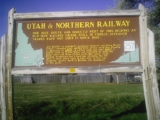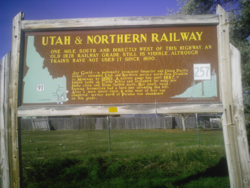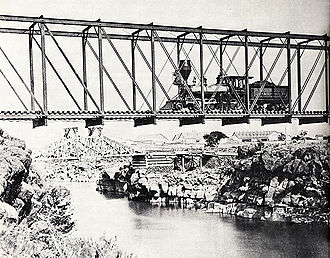
Utah and Northern Railway
Encyclopedia

Utah Territory
The Territory of Utah was an organized incorporated territory of the United States that existed from September 9, 1850, until January 4, 1896, when the final extent of the territory was admitted to the Union as the State of Utah....
and later in the Idaho Territory
Idaho Territory
The Territory of Idaho was an organized incorporated territory of the United States that existed from March 4, 1863, until July 3, 1890, when the final extent of the territory was admitted to the Union as the State of Idaho.-1860s:...
and Montana Territory
Montana Territory
The Territory of Montana was an organized incorporated territory of the United States that existed from May 28, 1864, until November 8, 1889, when it was admitted to the Union as the State of Montana.-History:...
in the western United States
United States
The United States of America is a federal constitutional republic comprising fifty states and a federal district...
during the 1870s and 1880s. It was the first railroad in Idaho
Idaho
Idaho is a state in the Rocky Mountain area of the United States. The state's largest city and capital is Boise. Residents are called "Idahoans". Idaho was admitted to the Union on July 3, 1890, as the 43rd state....
and in Montana
Montana
Montana is a state in the Western United States. The western third of Montana contains numerous mountain ranges. Smaller, "island ranges" are found in the central third of the state, for a total of 77 named ranges of the Rocky Mountains. This geographical fact is reflected in the state's name,...
.
The original 75 miles (120.7 km) of the Utah Northern Railroad (later named Utah and Northern Railway) was conceived and built by the Mormons. It was a narrow gauge spur off the Union Pacific
Union Pacific Railroad
The Union Pacific Railroad , headquartered in Omaha, Nebraska, is the largest railroad network in the United States. James R. Young is president, CEO and Chairman....
portion of the transcontinental railroad. The labor for this railroad was largely volunteer Mormon labor as the intent of the railroad was to serve the Mormon communities in the Cache Valley
Cache Valley
The Cache Valley is an agricultural valley of northern Utah and southeast Idaho that includes the Logan metropolitan area. The valley was used by 19th century mountain men and was the site of the 1863 Bear River Massacre.-History:...
that had been settled almost entirely by the Mormons. It was a case of Mormons forming a company and building their own railroad because existing railroad companies showed no interest in building such a railroad. The northern half of the Cache Valley is in Idaho and, due to claims and disputes by the Shoshone
Shoshone
The Shoshone or Shoshoni are a Native American tribe in the United States with three large divisions: the Northern, the Western and the Eastern....
and Bannock
Bannock
Bannock has more than one meaning:* Bannock , a kind of bread, usually prepared by pan-frying* Bannock , a Native American people of what is now southeastern Oregon and western Idaho* Bannock County, Idaho* Bannock, Ohio...
Indians, was not settled by the Mormons until after the Bear River Massacre
Bear River Massacre
The Bear River Massacre, or the Battle of Bear River and the Massacre at Boa Ogoi, took place in present-day Idaho on January 29, 1863. The United States Army attacked Shoshone gathered at the confluence of the Bear River and Beaver Creek in what was then southeastern Washington Territory. The...
and subsequent Fort Bridger Treaty of 1868
Fort Bridger Treaty Council of 1868
This Fort Bridger Treaty Council of 1868, was also known as the Great Treaty Council, was a council that developed the Fort Bridger Treaty of 1868 . The Shoshone, also referred to as the Shoshoni or Snake, were the main American Indian group affected by this treaty...
that forced the Shoshone and Bannock onto reservations. The original Mormon plan for the Utah Northern was to build a railroad to the communities in the Cache Valley and about 60 miles (96.6 km) into Idaho to Soda Springs, Idaho
Soda Springs, Idaho
Soda Springs is a city in Caribou County, Idaho, United States. The population was 3,381 at the 2000 census. The city is the county seat of Caribou County....
that lies in a valley beyond called the Bear River Valley. This was by dictate of Brigham Young as he owned land in Soda Springs and believed that the Bear River Valley had potential for further Mormon settlement. The Mormons also believed they could break the monopoly that the anti-Mormon town of Corinne, Utah
Corinne, Utah
Corinne is a city in Box Elder County, Utah, United States. The population was 685 at the 2010 census.-Geography:Corinne is located at ....
had on the wagon freight business on the Montana Trail
Montana Trail
The Montana Trail was wagon road that served gold rush towns such as Bannack, Virginia City and later Helena, Montana during the Montana gold rush era of the 1860s and 1870s. It branched from the Oregon Trail in southeastern Idaho and ran north through eastern Idaho along a well-established native...
by extending the railroad into Idaho. There were tentative plans to eventually extend the Utah Northern to Montana. The road was constructed northward from the Union Pacific line at Ogden commencing construction on August 24, 1871. In three years, the largely volunteer railroad company had built only 75 miles (120.7 km) of road. It reached Franklin, Idaho
Franklin, Idaho
Franklin is a city in Franklin County, Idaho, United States. The population was 641 at the 2000 census. It is part of the Logan, Utah-Idaho Metropolitan Statistical Area.-History:...
, just across the Idaho border, in May 1874 where construction was halted. Investors had become hesitant after the panic of 1873
Panic of 1873
The Panic of 1873 triggered a severe international economic depression in both Europe and the United States that lasted until 1879, and even longer in some countries. The depression was known as the Great Depression until the 1930s, but is now known as the Long Depression...
and the railroad was now moving into the northern half of the Cache Valley where there were many fewer Mormon volunteers due to this area only recently having been relinquished by the Bannock and Shoshone. Poor decisions by the planners and the lack of business from the frugal residents of the Cache Valley
Cache Valley
The Cache Valley is an agricultural valley of northern Utah and southeast Idaho that includes the Logan metropolitan area. The valley was used by 19th century mountain men and was the site of the 1863 Bear River Massacre.-History:...
led to the bankruptcy and foreclosure sale of the Utah Northern only a few years later in 1878.

Jay Gould
Jason "Jay" Gould was a leading American railroad developer and speculator. He has long been vilified as an archetypal robber baron, whose successes made him the ninth richest American in history. Condé Nast Portfolio ranked Gould as the 8th worst American CEO of all time...
who would transform the Utah Northern. He and Union Pacific
Union Pacific Railroad
The Union Pacific Railroad , headquartered in Omaha, Nebraska, is the largest railroad network in the United States. James R. Young is president, CEO and Chairman....
acquired the Utah Northern Railroad, changing the name to the Utah and Northern Railway and infusing the railroad with capital. Big business knew that an electrical age was coming and that the demand for copper switches, copper bars, copper fittings, and most importantly, copper wire was putting a charge on copper prices. They also knew that there were rich copper deposits at the mines near Butte, Montana
Butte, Montana
Butte is a city in Montana and the county seat of Silver Bow County, United States. In 1977, the city and county governments consolidated to form the sole entity of Butte-Silver Bow. As of the 2010 census, Butte's population was 34,200...
. Union Pacific wasted no time and resumed construction on the Utah and Northern Railway immediately after purchase in April 1878. In fact, Jay Gould invested personal money to get some construction started just beyond Franklin in the fall of 1877. The new plan was not to build the road to Soda Springs, however, but to build a much longer road on a direct route through the Cache Valley, then north across eastern Idaho and north across western Montana to Butte, Montana. In the first year of construction, they reached Eagle Rock (now Idaho Falls, Idaho
Idaho Falls, Idaho
Idaho Falls is a city in and the county seat of Bonneville County, Idaho, United States, and the largest city in Eastern Idaho. As of the 2010 census, the population of Idaho Falls was 56,813, with a metro population of 130,374....
), 120 miles (193.1 km) north of the Utah/Idaho border, where they built a bridge across the Snake River
Snake River
The Snake is a major river of the greater Pacific Northwest in the United States. At long, it is the largest tributary of the Columbia River, the largest North American river that empties into the Pacific Ocean...
in early 1879. In the second year, they added another 90 miles (144.8 km) of track and crossed the continental divide
Continental divide
A continental divide is a drainage divide on a continent such that the drainage basin on one side of the divide feeds into one ocean or sea, and the basin on the other side either feeds into a different ocean or sea, or else is endorheic, not connected to the open sea...
at the Idaho/Montana border. After three and a half years of construction, before the close of 1881, they completed the additional 120 miles (193.1 km) of road to Butte, Montana. Butte soon grew to be the largest copper producing city in the world and Butte's population, by some estimates, grew to nearly 100,000 residents for a time, making Butte, with its "Copper Kings
Copper Kings
The Copper Kings, industrialists William Andrews Clark, Marcus Daly, and F. Augustus Heinze, were collectively known for the epic battles they fought in Butte, Montana and the surrounding region during the Gilded Age over the control of the local copper mining industry, a fight which had...
," the second largest city in the West with more influence than Salt Lake City, Denver, Sacramento, Seattle, or Portland. Only San Francisco remained larger and more important. Butte, with its large-scale mining and smelting operations, was dubbed the Pittsburg of the West.
The Utah and Northern was switched from narrow gauge to standard gauge in the summer of 1886 only five years after completing the line to Butte. The railroad operated successfully for several years and finally became a branch of the Union Pacific Railroad.
External links
- Ogden Rails: Utah Northern, Utah & Northern (with citations)

